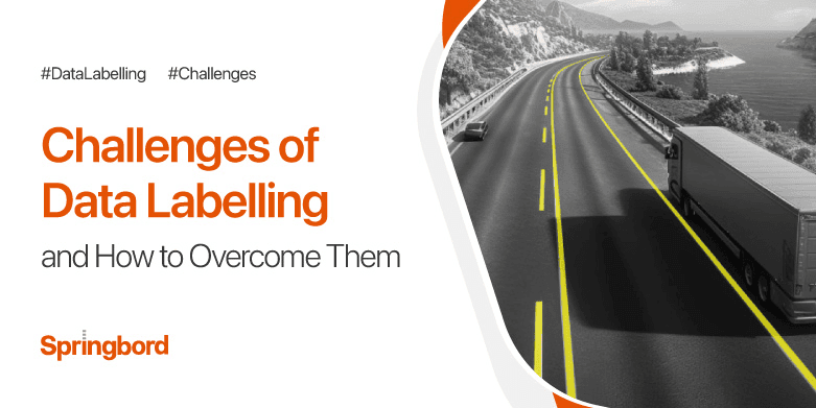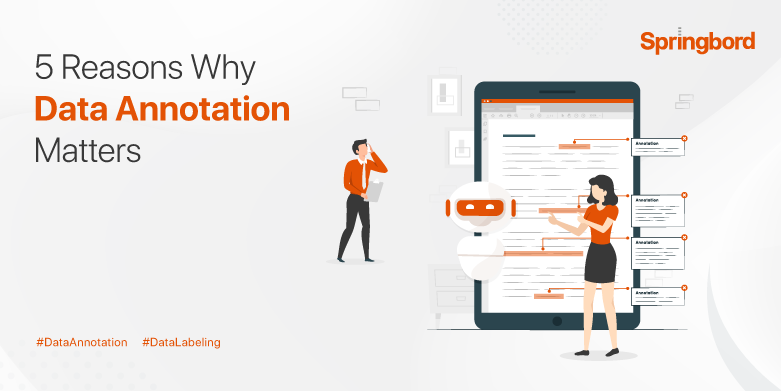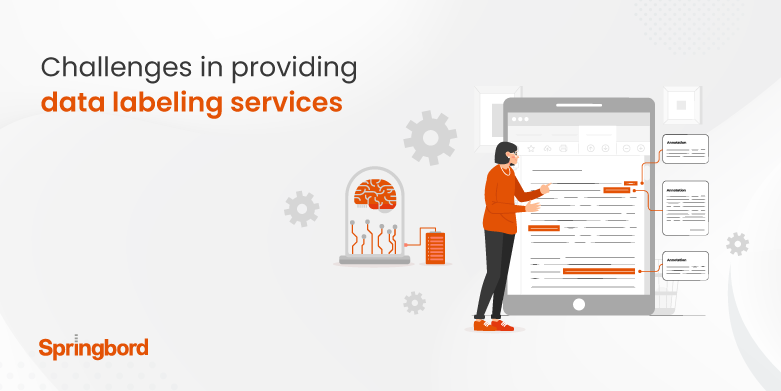 Read time 9 min
Read time 9 minUnlock the secrets of cutting-edge AI and machine learning as we delve into the intriguing world of data labelling challenges.
Also, Learn about the roadblocks that prevent the compilation of trustworthy datasets and investigate novel approaches to removing them.
Introduction
Data labelling is an essential component of machine learning and AI, and it is required for training accurate models. However, the Challenges of data labelling are considerable, affecting the quality and effectiveness of AI systems.
Overcoming these challenges is critical for ensuring reliable and unbiased outcomes. Addressing the challenges of data labelling necessitates using modern methodologies, automated solutions, and promoting best practices.
This article highlights the significance of navigating the challenges of data labelling to empower AI advancements effectively.
Challenges of Data Labelling
Data labelling is a crucial step in developing AI and machine learning models. Annotating raw data with relevant and precise information enables algorithms to detect patterns, forecast outcomes, and complete jobs.

However, data labelling comes with challenges that can significantly impact the performance and reliability of AI systems.
- Ambiguity and Subjectivity in Labelling Tasks One of the biggest challenges in data labelling is the ambiguity and subjectivity of specific labelling tasks. In image recognition tasks, for instance, there may be inconsistent annotations because annotators have different understandings of the same scene.
This discrepancy can introduce noise and lower the quality of labelled data, affecting the accuracy and robustness of the artificial intelligence model.
- High Cost and Time-Consuming Nature of Manual Data Labelling: Manual data labelling is widely used for creating labelled datasets. It can be a time-consuming and strenuous process, though.
For huge datasets, the expense of hiring skilled human annotators to identify each data point manually can add up quickly. Furthermore, the sheer volume of data created in many fields calls for fast and cheap labelling strategies.
- Lack of Domain Expertise: Data labelling often requires domain-specific knowledge to interpret and label the data accurately. Annotators’ lack of knowledge may result in incorrect or incomplete labels.
For instance, labelling in medical picture analysis requires extensive knowledge of medical jargon and illnesses. The true properties of the underlying data distribution may only be reflected in the labelled data with sufficient domain expertise.
- Dealing with Unstructured and Noisy Data: Data from the real world often needs more organization, is noisy, and may be missing or irrelevant. Extensive data preprocessing is required before the actual labelling process to clean and transform the data into a usable format.
Because of the potential for annotators to be misled and inaccurate labels to be produced, data cleaning and preprocessing are essential but difficult processes in the data labelling pipeline.
- Scaling Data Labelling for Large Datasets: Labelling data for huge datasets at scale is a difficult problem because data is growing exponentially, especially in areas like natural language processing and computer vision.
Manual labeling becomes infeasible due to time restrictions and financial concerns when dealing with massive amounts of data. Due to this, accurate automated data labelling is a must. Still, it comes with its own set of difficulties, such as dealing with different types of data and ensuring consistent labelling.
- Addressing Potential Bias in Labelling: To ensure that AI models are fair and inclusive, it is important to address the possibility of bias during data labelling. Annotators’ own prejudices, skewed data in training, and cultural and social norms are all potential sources of bias in the annotation process.
The use of biassed data in the training of AI models can lead to discriminatory outcomes or choices. In order to construct AI systems that are both ethical and objective, it is essential to detect and correct for bias in data labelling.
Techniques for Overcoming Data Labelling Challenges
Overcoming the challenges of data labelling is essential to ensure the quality and reliability of labelled datasets, which serve as the foundation for training machine learning and AI models. Various techniques and strategies have been developed to address these challenges effectively.
- Active Learning: One such effective method is active learning, which selects the most illuminating samples for human annotation in order to streamline the data labelling process.
Instead of picking data points at random, active learning algorithms pinpoint situations when the model is unsure or is likely to underperform. By giving the model access to the most pertinent data and decreasing the total labelling workload, we may prioritise these samples for manual labelling.
Active learning can achieve excellent performance with a small number of labelled samples by continuously updating the model with fresh data. Data labelling problems can be solved efficiently and cheaply with this method, which is especially helpful when human labelling is involved.
- Semi-Supervised Learning: Semi-supervised learning is another valuable technique for overcoming data labelling challenges, especially when dealing with large-scale datasets.
The model is trained with both labelled and unlabeled data in semi-supervised learning. The model can generalise more effectively with the help of both the labelled and unlabeled data, the former of which gives explicit supervision.
When it’s too time-consuming or expensive to collect a significant amount of labelled data, this method comes in handy. Semi-supervised learning, which incorporates unlabeled data into the learning process, can outperform fully supervised approaches with a fraction of the number of labelled examples.
- Crowdsourcing: Crowdsourcing is widely used to address the problem of scaling data labelling for massive datasets. It entails sending labelling jobs out to various people through the use of online marketplaces.
When dealing with massive amounts of data that a small in-house staff cannot efficiently identify, crowdsourcing is a great option for achieving rapid and low-cost data annotation.
Crowdsourcing has its benefits, but it also comes with its own set of difficulties, such as verifying the accuracy and consistency of annotations made by people who may not be experts in the field.
To solve this problem, we need to establish rules, quality assurance procedures, and validation checks to guarantee the integrity of the information on the labels.
- Automated Labelling: The restrictions of manual labour and expense make automated labelling techniques useful for addressing the difficulties of data labelling. In automated labelling, labels are generated mechanically through the use of rule-based methods, weak supervision, or other AI techniques.
To classify data, rule-based methods construct explicit rules or heuristics based on expert knowledge. Using noisy or partial labels, weak supervision trains models on the premise that supervision information is present in the data.
While automated labelling can greatly lessen the need for human intervention, it is essential to ensure that the labels produced are accurate and reliable. Errors and biases introduced by these methods should be discovered and eliminated through validation and verification efforts.
- Human-in-the-Loop: Human-in-the-loop (HITL) approaches combine the efforts of both human laborers and AI algorithms. The model makes predictions at the outset, which human annotators then review and adjust in an iterative process. Once the errors have been fixed, the data is used to retrain the model.
HITL methods excel at jobs when the model’s preliminary forecasts are shaky or nebulous. More accurate annotations and enhanced models can result from human reviewers’ insightful and contextual feedback.

- Quality Control Mechanisms: To ensure the success of AI models, it is essential to have quality control mechanisms in place to ensure the accuracy and completeness of labelled data.
Labelling mistakes and discrepancies can be found and fixed with the use of quality control procedures. Cross-validation, inter-rater reliability checks, and adversarial testing are examples of the procedures that might be used.
Human error and inconsistency in data labelling can be effectively mitigated through routine validation of the labelled data and resolution of differences.
Automated Data Labelling Solutions
Automated data labelling solutions have emerged as valuable tools in machine learning and artificial intelligence, offering efficient and cost-effective alternatives to traditional manual labelling processes.
These solutions streamline the data preparation phase and quicken the model creation process by automatically assigning labels to raw data using a variety of methodologies and algorithms.
- Rule-Based Labelling: A simple method of automated data labelling, rule-based labelling uses previously stated rules to apply labels to data.
Using these rules, the system can categorize data points according to a specified set of circumstances, which are the result of domain expertise and specific criteria.
In text classification, for instance, one may create a rule that classifies all papers with a given set of keywords into a given category. Simple to execute, rule-based labelling might be helpful for jobs with obvious patterns when creating manual rules is manageable.
- Weak Supervision: Weak supervision is a method for producing approximate labels for data by using imperfect or noisy sources of supervision. This approach recognizes the difficulty and expense of collecting complete labels for data.
To infer labels for data points, weak supervision relies on several potentially conflicting sources of information. Annotations from the general public, experts, or even a computer system could be used.
Weak supervision combines these noisy signals into pseudo-labels to train machine learning models. However, the increased efficiency and scalability of the data labelling process are worth the risk of inaccuracy introduced by insufficient supervision.
- Transfer Learning: Transfer Learning is a well-liked method for applying the expertise of previously-trained models to unlabeled problems. Transfer learning involves refining a model already trained on an extensive dataset to recognize general patterns by using a smaller labelled dataset for the target task.
There is less of a need for a large amount of labelled data thanks to the pre-trained model’s ability to collect useful feature representations that can be applied to the new task.
Large pre-trained models, such as convolutional neural networks (CNNs) and transformer-based models, have achieved significant results in computer vision and natural language processing applications, making transfer learning especially useful.
Data Labelling Best Practices
Data labelling is a critical step in the process of training machine learning and artificial intelligence models. Data labeling best practices must be followed to ensure the accuracy, reliability, and fairness of AI systems.
These practices encompass various guidelines and methodologies that aim to produce high-quality labelled datasets.
- Clear Annotation Guidelines: The first step in ensuring labeling uniformity and accuracy is establishing clear and extensive annotation rules.
Labelling criteria, directions for handling grey areas, and handling of special circumstances should all be spelled out in the annotation rules. Having well-defined rules can reduce labelers’ bias and produce more consistent annotations.
- Training and Continuous Monitoring of Labelers: Continuous monitoring of labelers is also important to ensure they follow the annotation rules and do a good job.
The labelling process may be improved, and consistent monitoring and feedback sessions can resolve any doubts. Maintaining a high quality standard in the labelled datasets is facilitated by regular communication with the labelers.
- Regular Validation of Labelled Data: Regularly validating labelled data against ground truth labels or expert annotations is essential for detecting and rectifying labelling errors.
Inconsistencies and errors in the labelled dataset can be fixed by running it through a validation process. The quality of the labelled data as a whole benefits from a systematic approach to validation.
- Collaborating with Domain Experts:
Working together with subject matter experts is invaluable when a task requires expertise in a specific area.
Experts in the relevant field can contribute insightful knowledge, tackle challenging situations, and guarantee that the labelled data meet the AI application’s needs.
The quality and utility of the annotations can be enhanced by incorporating the knowledge of subject experts into the labelling process.
- Quality Control Mechanisms: When quality control measures are built into the labelling procedure, mistakes in labelling can be found and corrected methodically.
Inconsistencies in the labelled dataset can be discovered and improved upon by employing methods like cross-validation, inter-rater reliability tests, and data validation against gold standard labels. The trustworthiness of the labelled data is ensured by routinely monitoring quality control criteria.
To Sum Up
The challenges of data labelling are significant in developing accurate and reliable AI and machine learning models. However, as data science develops, more efficient methods of overcoming these challenges are becoming available.

Springbord is a frontrunner among worldwide information service providers due to its competence in helping clients overcome data labelling issues and guaranteeing high-quality annotations. Using state-of-the-art Internet-based capabilities, they provide tailor-made solutions for data collecting and processing to businesses of all kinds.
Springbord is a great partner in navigating the intricacies of data labelling and promoting innovation in artificial intelligence because of its dedication to providing high-quality business process outsourcing services to clients in the private and public sectors.
FAQ
1. What are the major challenges in data labelling for AI and machine learning?
Common challenges include ambiguity in annotations, high manual costs, lack of domain expertise, dealing with noisy or unstructured data, and the risk of bias in labelling.
2. How can automated labelling help overcome manual annotation issues?
Automated labelling uses rule-based systems, weak supervision, or AI models to apply labels efficiently, reducing time and costs while minimizing human errors—though it still requires validation to ensure accuracy.
3. What is Human-in-the-Loop (HITL) and why is it important in data labelling?
HITL combines machine-generated annotations with human review and correction. It helps improve model accuracy by integrating expert judgment into the labelling pipeline, especially where AI predictions are uncertain.
4. Why is data labelling essential for machine learning?
Labeled data is the foundation of supervised learning—it teaches models how to make accurate predictions by providing examples of input-output relationships.
5. What tools are commonly used for data annotation?
Popular tools include Labelbox, Amazon SageMaker Ground Truth, CVAT, and Prodigy, offering features like bounding boxes, segmentation, text tagging, and collaborative workflows.
6. How can organizations ensure quality control in data labelling?
By using clear annotation guidelines, conducting inter-rater reliability checks, employing validation against gold standards, and continuously training annotators.
7. What is the role of domain experts in data annotation projects?
Domain experts ensure that annotations are contextually accurate—vital in specialized fields like medical imaging, legal documents, or financial data, where deep subject knowledge is required.







